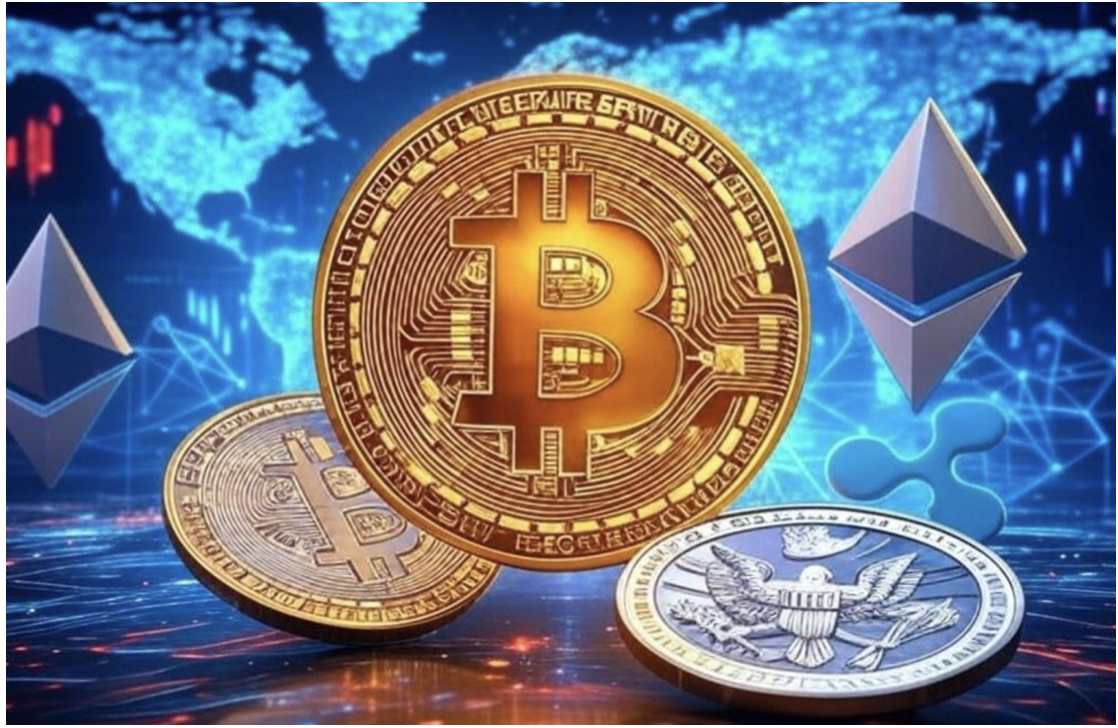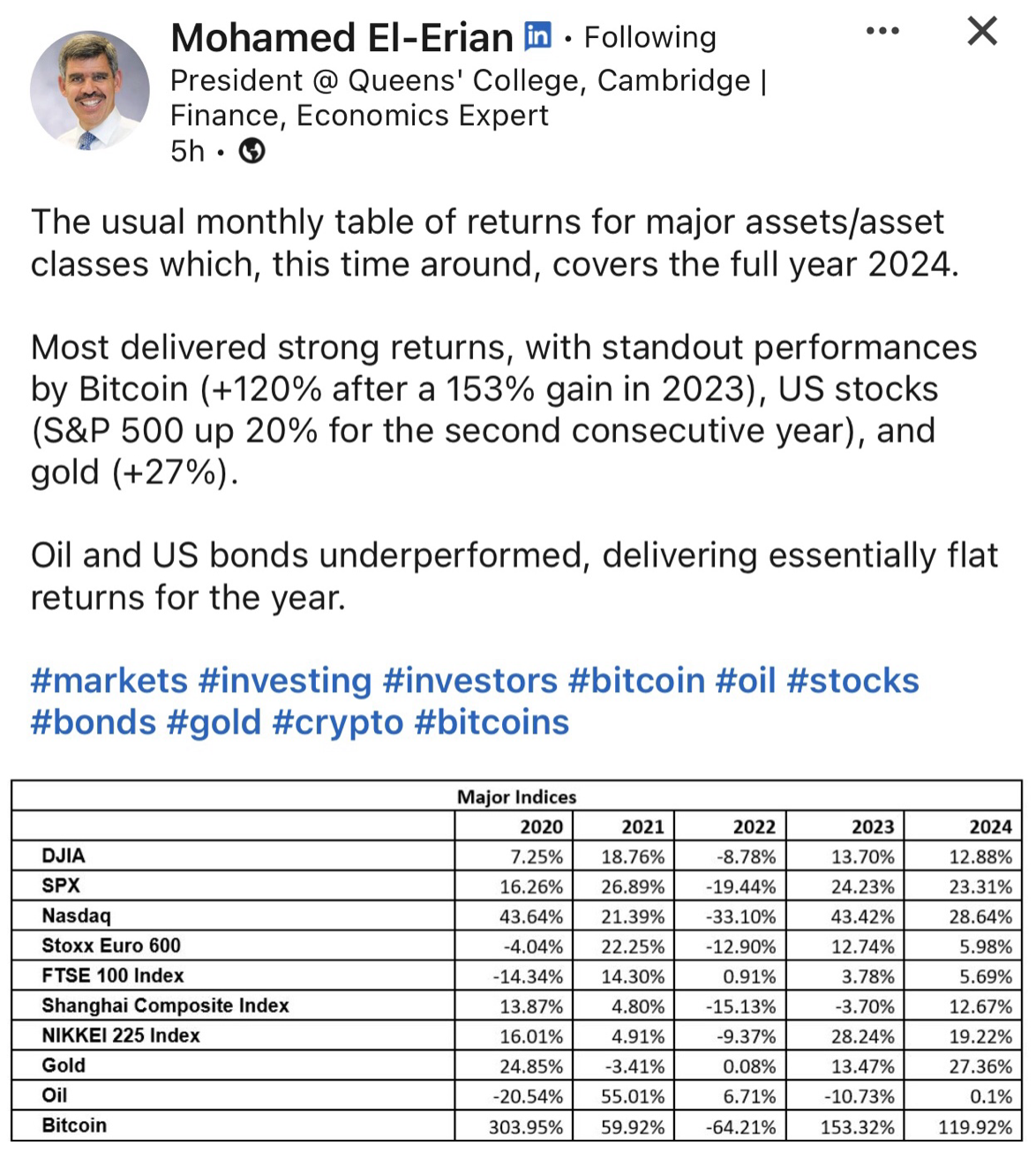
(IN 2024, THE TRADITIONAL SANTA RALLY DIDN’T APPEAR, SO WHAT DOES 2025 AND BEYOND LOOK LIKE?)
January 6, 2025
Hello everyone
Happy New Year! Wishing you all good things for 2025.
I’m back on deck for a new year. I hope you are all well-rested and ready for another year navigating the markets.
So, what can we expect for 2025?
In Australia, economists indicate that 2025 offers no solutions to the economic problems of the past year. However, we can expect an easing of interest rates and inflation.
China’s sluggish economy has the potential to weigh down Australia.
US President-elect Donald Trump will be inaugurated for a second term later in January, with the full extent of his promised tariffs a key factor for the economic outlook.
He’s pledged the mass deportations of migrant workers and a huge reduction in government regulation of different industries.
For the economy, the biggest impact will likely be from tariffs imposed on goods from foreign countries, including steep taxes on Mexico, Canada, and China.
It is yet unknown whether Trump will follow through on the announced rate of tariffs on these countries.
(DOGE) leader Elon Musk could trim the fat in government departments, making the system work more efficiently.
Unemployment begins to rise in 2025.
Interest rates are finally cut in Australia in the first half of the year.
In the last two decades, in Australia, migration increased to about 60 percent of growth in an average year and natural increases were the other proportion – about 40 percent.
Migration is now up to 83 percent of our growth … so, record population increases in Australia.

Demographer, Mark McCrindle, believes Australia’s population could reach 50 million by the 2050’s.
He also points out, that Australia is not keeping up with a heightened population demand on critical infrastructure such as housing.
McCrindle argues that the “population growth is greater than the built environment growth and that’s really what’s driving the housing affordability challenges, that demand is exceeding supply.”
So, as you can imagine, no relief yet on Australia’s housing crisis. (It is a similar story in the U.S.)
People will continue to move to regional areas away from the big cities – Sydney & Melbourne – to look for affordable living options with flexible working conditions.
Globally, McCrindle predicts the population will grow as high as 10 billion by the 2080’s, before stabilizing. He said the world was already experiencing increased rates of population contraction – meaning fewer people are being born annually – and this trend was likely to continue.
We will continue to see technological innovations. AI technology is on our doorstep, but Australians appear to be slow to take up new technologies. An attitude of distrust seems to be an issue. The AI “big brother” lens is not palatable for everyone. Nevertheless, AI will no doubt increase efficiency and cut costs in many sectors & industries, which will likely be passed on to the consumer. The chip industry and the main heavyweights will continue to do well as demand will not go away. Quantum computing is not far away.
Geopolitical conflicts have been increasing in intensity in the last few years. Strategic Analysis Australia founder, Michael Shoebridge, argues there is a credible scenario “There could be a global war this decade and that can be because of the rise of nationalism we’re seeing, particularly in places like Russia and China.”
Shoebridge comments that just like before World War I, the world in 2025 is witnessing a “revolution in warfare” with newly innovated weaponry, and leaders like Russian President Vladimir Putin, Chinese President Xi Jinping, and the United States president-elect Donald Trump blindly moving closer to a full-scale war.
S&P500
2024 was a stellar year for stocks, but in 2025 Equities may pause for a period this year before another major rally takes place.
Over a period of 6-9 months, the S&P500 could possibly fall towards $4,800, or even lower, but will then rally in the final part of the year. 2026 and 2027 could be good years for the market.
If the markets do take the bear path, FANG stocks could fall 20% or more.
Of course, these predictions depend, somewhat, on what Donald Trump actually does when he enters the White House. If nothing changes, then a rally could well take place, and stocks could rise into nosebleed territory. Time will tell.
PRECIOUS METALS
Gold and silver will remain financial safe havens. As confidence in fiat currencies erodes amidst economic instability, gold, silver, and cryptocurrencies are emerging as pillars of financial security. With geopolitical tensions rising, central banks hoarding reserves, and inflation fears mounting, many analysts project gold could rally toward $3,500 per ounce – and possibly higher. Unlike fiat money, gold isn’t tied to the whims of governments or central banks, making it a trusted store of value during crises.
I see gold and silver continuing to range in the first instance this year and then, possibly, gradually moving lower towards $2,400 and even $2,200 is possible. In the second half of the year, we could see a rally towards $3,000. Late last year I suggested selling calls on gold and silver stocks. At the moment this is still a good play.
THE CRYPTO REVOLUTION
Crypto should shine this year. The election of Donald Trump has shaken up the markets, particularly in the cryptocurrency space. His administration has swiftly installed crypto-friendly leaders in key positions, including Vice President JD Vance, National Security Advisor Michael Waltz, Commerce Secretary Howard Lutnick, Treasury Secretary Scott Bessent, SEC Chairman Paul Atkins, FDIC Chair Jelena McWilliams, Dept of Govt Efficiency (DOGE) leader Elon Mush, and HHS Secretary RFK Jr., who has become the face of the MAHA (Make America Healthy Again) movement. These appointments signal the end of anti-crypto policies while positioning Bitcoin and other digital assets as strategic components of the U.S. economy.
Bitcoin is expected to rally well this year. With increasing institutional adoption, corporate treasuries diversifying into Bitcoin, and even nation-states taking on board the idea, Bitcoin could easily reach $150,000 and beyond this year. Some are even predicting $250,000 by December.
Why is this happening now?
Many factors:
Greater regulatory clarity, the launch of Bitcoin exchange-traded products (ETPs), and institutional players continuing to pour large amounts of capital into Bitcoin. These developments not only seem to set Bitcoin’s position as a store of value but signal that it’s well on its way to becoming a dominant force in the global economy.
Bitcoin isn’t the only crypto that will rally this year. Investors and/or traders should also be looking at Ethereum. This coin has a valuable ecosystem of decentralized applications (d’Apps) and smart contracts. The introduction of Ethereum 2.0, which promises faster transactions and a more energy-efficient proof-of-stake mechanism, combined with Ethereum’s role at the heart of decentralized finance (DeFi), may well incentivise mass adoption. With more institutions and businesses adopting Ethereum-based platforms, the token could rally strongly, riding the wave of growing trust in blockchain technology. There is potential for Ethereum to rally towards $8000.

Another coin that could have a bright future is Ripple. Some experts are predicting that XRP could hit $10 in 2025. Faster, cheaper transactions offer banks and corporations a more efficient way to process payments across borders, making it a preferred choice for many in the financial world. Further igniting its popularity is the endorsement by high-profile figures like Elon Musk, who recently mentioned XRP in the context of his support for decentralized technologies. Musk’s influence could boost XRP’s visibility and attract new investors and institutional partners. As blockchain technology continues to reshape the global financial landscape, Ripple’s XRP could become the backbone of cross-border payments, setting its place as a key player in the future of global finance.
Utility coins, too, are gaining acceptance and popularity. These coins go beyond mere speculations, offering real-world value by supporting initiatives and candidates committed to preserving liberty and individual rights. For example, USA Unity Coin (UUC) empowers Americans to back pro-freedom political leaders while participating in a decentralized financial ecosystem. Coins like UUC are providing a unique opportunity to drive change. UUC, in particular, is on a mission to safeguard the principles of freedom in the digital age.
ENERGY
Energy was one of the worst-performing sectors last year. Will it be the same this year? Much depends on supply and demand, and the ongoing conflicts around the world.
Geopolitical risks threaten investment, environmental regulations, and infrastructure.
In 2025 oil prices could keep ranging for a period before the market finds a low and a bullish move begins.
Hold on to traditional energy stocks like (XOM)Exon Mobil, (CVX) Chevron, and (OXY)Occidental Petroleum. They should do well in the future.
By 2030, the use of renewables will probably increase by over 430%. Nuclear energy and hydroelectricity will expand by 54.5% and 48.5% respectively.
So, nuclear energy stocks should definitely be on your list. Look at (CCJ) Cameco Corp. (VST) Vistra Energy (a good buy now- scale in), (CEG) Constellation Energy, (SMR) Nu-Scale Power Corporation (A good buy now –scale in)
Santa didn’t deliver at the close of 2024
In contrast to what had been a very strong 2024 performance, the year ended without any fanfare at all. The S&P500 rose more than 23% last year but ran out of puff at year's end. Does the absence of a Santa rally mean a lacklustre market or a period of underperformance lies ahead for stocks? Some analysts believe the returns may not be as robust as in years when we did enjoy a Santa rally. On average then, we can expect around a 6.5% return. At any rate, January usually sets the tone for the rest of the year, so we need to take note and see what markets are telling us. History reminds us that when January is positive, the S&P500 averages a 6.9% gain on a six-month forward basis. When it’s negative, the index falls 0.6%.
The December jobs report is released this Friday. And with inflation data released later this month, we could get a much clearer picture of the path of interest rates going forward. A slowdown in job growth is expected. This week will be a good test for the dollar, with employment statistics and Fed speeches.
WEEK AHEAD CALENDAR
Monday Jan. 6
9:45 a.m. PMI Composite final (December)
9:45 a.m. S&P PMI Services final (December)
10:00 a.m. Durable Orders final (November)
10:00 a.m. Factory Orders (November)
Tuesday Jan.7
8:30 a.m. Trade Balance (November)
10:00 a.m. ISM Services PMI (December)
10:00 a.m. JOLTS Job Openings (November)
9:00 a.m. Euro Area Inflation Rate
Previous: 2.2%
Forecast: 2.4%
Wednesday Jan. 8
8:15 a.m. ADP Employment Survey (December)
8:30 a.m. Jobless Claims (week ending 12/28)
2:00 p.m. FOMC Minutes
3:00 p.m. Consumer Credit (November)
Thursday Jan 9
10:00 a.m. Wholesale Inventories final (November)
NYSE is closed to mourn the death of President Jimmy Carter.
Earnings: Constellation Brands
Friday Jan10
8:30 a.m. December payrolls
10:00 a.m. Michigan Sentiment preliminary (January)
Earnings: Walgreens Boots Alliance, Delta Air Lines
QI CORNER



HISTORY CORNER
On January 3rd



Cheers
Jacquie

